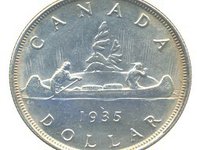
Loons and toons of Canadian dollar

Canada, an amazing, multiethnic, multicultural, and the world's second largest country is located in the north of the American continent. Founded by Frenchman Jacques Cartier in 1534, Canada experienced French and English colonizations. Today, it is an independent country with a diversified economy and its own currency called the Canadian dollar.
The national currency was introduced in Canada in 1858. Previously, the residents of the territories that presently belong to the government in Canada, used to have Spanish dollars or reais that were in circulation in the Spanish colonies. The real predecessor of the Canadian currency was the money that was also known as 'dollar' - it appeared in the British province of Canada in 1841.
The cost of those dollars was equal to the cost of the gold dollar from the U.S. One dollar of the Canadian province consisted of five shillings. Interestingly, the French-speaking part of Canada still calls dollars piasters, and cents - sou, thus paying tribute to traditional names of the currencies in French colonies.
First dollar banknotes appeared in Canada in the early 19th century. The paper money was issued by the British Army between 1813 and 1815 . Afterwards, the emission of Canadian dollar notes was started by chartered banks, from the 1830 - by the colonial administration, and from the 1970s - by the Confederation of Canada.
The National Bank of Canada was established is 1935. Since that moment, the issuance of local money was entrusted to a new institution, which changed the familiar design of banknotes at once. The notes were issued in denominations of 1, 2, 5, 10, 20, 25, 50, 100, 500 and 1,000 dollars. After almost ten years, all chartered banks were deprived of the right to issue their own money. Nowadays, the Canadian dollar is printed by the Royal Bank of Canada and by the Bank of Montreal.
Among all other currencies of the world, the Canadian dollar stands out for its high degree of protection, which the currency had from the very beginning of production. Local notes had various shape and colors in different times, but in comparison with the money of other countries, Canadian dollars always had a rich format to display identification elements.
The banknotes and coins of Canadian dollars have a landscape on one side: snow-capped mountains, plains, high fur trees, and various animals, such as bears, beavers, some species of birds and so on. It is worthy of note that the Canadian dollar coins are known as 'loonie' - from the word 'loon,' which stands for the North American name of a waterfowl. The loon, just like the maple leaf, are widely known as symbols of Canada.
The loon, immortalized in Canadian money, looks like a duck. The bird inhabits the north of Canada, Alaska and Eurasia, the lakes of tundra, forest tundra and northern taiga. These birds feed exclusively on small fish; the scaring sounds that they produce at night resemble human laughter. The loon is also the official bird of the capital of Canada - Ontario. Noteworthy, the two-dollar coin, made of two alloys, is known as the 'toonie'.
In addition to wildlife and local symbols, Canadian dollars depict the portrait of Her Majesty Queen Elizabeth II that can often be found on the notes and coins of the British Commonwealth. In addition to the famous monarch, the local money glorifies politicians and scientists of Canada, who went down in history in different times: Wilfrid Laurier, John McDonald, William Lyon Mackenzie King, Robert Borden.
Five years ago, the Canadian dollar was ranked seventh among the world's most traded currencies. However, the rate of the Canadian dollar fluctuates on news from the United States, as the US of A acts as the most important sales market for Canada. From 2005 to 2007, as a result of negative trends in the U.S. economy, the Canadian dollar began to decline in value. Today, when the crisis tortures the largest economies in the world, Canada also experiences hard times and trade deficit. Nevertheless, the role of the Canadian dollar on the world market remains one of the principal ones. As before, the currency of the technologically advanced and industrialized country remains the most geographically widespread and expensive currency in the world.
Maria Snytkova.